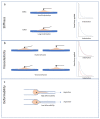Biomechanical Properties of Cancer Cells
- PMID: 33924659
- PMCID: PMC8069788
- DOI: 10.3390/cells10040887
Biomechanical Properties of Cancer Cells
Abstract
Since the crucial role of the microenvironment has been highlighted, many studies have been focused on the role of biomechanics in cancer cell growth and the invasion of the surrounding environment. Despite the search in recent years for molecular biomarkers to try to classify and stratify cancers, much effort needs to be made to take account of morphological and nanomechanical parameters that could provide supplementary information concerning tissue complexity adaptation during cancer development. The biomechanical properties of cancer cells and their surrounding extracellular matrix have actually been proposed as promising biomarkers for cancer diagnosis and prognosis. The present review first describes the main methods used to study the mechanical properties of cancer cells. Then, we address the nanomechanical description of cultured cancer cells and the crucial role of the cytoskeleton for biomechanics linked with cell morphology. Finally, we depict how studying interaction of tumor cells with their surrounding microenvironment is crucial to integrating biomechanical properties in our understanding of tumor growth and local invasion.
Keywords: biomarker; biomechanics; cancer.
Conflict of interest statement
The authors declare no conflict of interest.
Figures


References
Publication types
MeSH terms
LinkOut - more resources
Full Text Sources
Other Literature Sources
Medical

